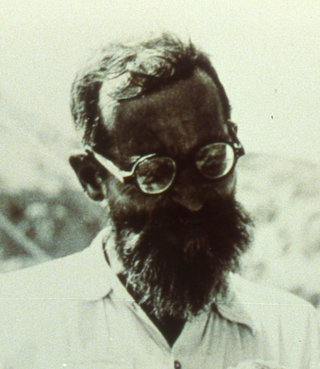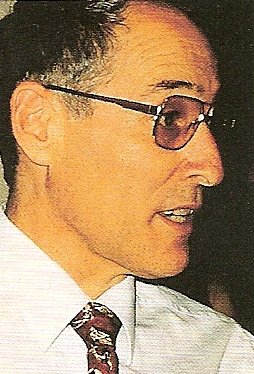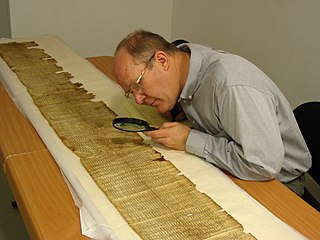Related Research Articles

The Dead Sea Scrolls are ancient Jewish and Hebrew religious manuscripts discovered between 1946 and 1956 at the Qumran Caves in what was then Mandatory Palestine, near Ein Feshkha in the West Bank, on the northern shore of the Dead Sea. Dating from the 3rd century BCE to the 1st century CE, the Dead Sea Scrolls are considered to be a keystone in the history of archaeology with great historical, religious, and linguistic significance because they include the oldest surviving manuscripts of entire books later included in the biblical canons, along with deuterocanonical and extra-biblical manuscripts which preserve evidence of the diversity of religious thought in late Second Temple Judaism. At the same time they cast new light on the emergence of Christianity and of Rabbinic Judaism. Most of the scrolls are held by Israel in the Shrine of the Book at the Israel Museum, but their ownership is disputed by Jordan due to the Qumran Caves' history: following the End of the British Mandate for Palestine in 1947, Jordan occupied the area in the 1948 Arab–Israeli War, and Israel captured both the area and several Scrolls from Jordan in the 1967 Six Day War. However, some of the scrolls are still in Jordan and are now displayed at The Jordan Museum in Amman. Ownership of the scrolls is also contested by the State of Palestine.

John Marco Allegro was an English archaeologist and Dead Sea Scrolls scholar. He was a populariser of the Dead Sea Scrolls through his books and radio broadcasts. He was the editor of some of the most famous and controversial scrolls published, the pesharim. A number of Allegro's later books, including The Sacred Mushroom and the Cross, brought him both popular fame and notoriety, and also complicated his career.

Roland Guérin de Vaux was a French Dominican priest who led the Catholic team that initially worked on the Dead Sea Scrolls. He was the director of the Ecole Biblique, a French Catholic Theological School in East Jerusalem, and he was charged with overseeing research on the scrolls. His team excavated the ancient site of Khirbet Qumran (1951–1956) as well as several caves near Qumran northwest of the Dead Sea. The excavations were led by Ibrahim El-Assouli, caretaker of the Palestine Archaeological Museum, or what came to be known as the Rockefeller Museum in Jerusalem.
Emanuel Tov, is a Dutch–Israeli biblical scholar and linguist, emeritus J. L. Magnes Professor of Bible Studies in the Department of Bible at the Hebrew University of Jerusalem. He has been intimately involved with the Dead Sea Scrolls for many decades, and from 1991, he was appointed Editor-in-Chief of the Dead Sea Scrolls Publication Project.
4Q108 is a fragment containing a portion of the Song of Songs (3:7–8) in Hebrew. Fragments from three such scrolls were found in Cave 4 at Qumran. These, and 6Q6 from Cave 6, estimated from 2nd century BCE, comprise the total witness to the Song from the Dead Sea Scrolls, known so far.

Elisha Qimron is an academic who studies ancient Hebrew. He took his Doctor of Philosophy in 1976 at the Hebrew University of Jerusalem with the dissertation The Hebrew of the Dead Sea Scrolls.

4QMMT, also known as MMT, or the Halakhic Letter, is a reconstructed text from manuscripts that were part of the Dead Sea Scrolls discovered at Qumran in the Judean desert. The manuscripts that were used to reconstruct 4QMMT were found in Cave 4 at Qumran between the years 1953 and 1959. They were kept at the Palestinian Archaeological Museum, now known as the Rockefeller Museum in Jerusalem.
4Q106 is one large and three small fragments from three columns of a scroll containing portions of the Song of Songs in Hebrew. It is one of three scrolls found in Cave 4 at Qumran that have been reconstructed as copies of the Song of Songs. These, and 6Q6 from Cave 6, comprise the total witness to the Song from the Dead Sea Scrolls, known so far.
Discoveries in the Judaean Desert (DJD) is the official 40-volume publication that serves as the editio princeps for the Dead Sea Scrolls. It is published by Oxford University Press.
Eugene CharlesUlrich is an American Dead Sea scrolls scholar and the John A. O'Brien Professor emeritus of Hebrew Scripture and Theology in the Department of Theology at the University of Notre Dame. He is chief editor of the biblical texts of the Dead Sea scrolls and one of the three general editors of the Scrolls International Publication Project. Ulrich has worked under two editors in chief on the scrolls project, namely John Strugnell and Emanuel Tov.

Donald W. Parry Ph.D. is a professor of Hebrew Bible in the Department of Asian and Near Eastern Languages at Brigham Young University. He holds the Abraham O. Smoot Professorship. He is the author and editor of many works related to the Dead Sea Scrolls and the Hebrew Bible, Old Testament. He has been a member of the International Team of Translators of the Dead Sea Scrolls since January 1994. He served as a member of the Dead Sea Scrolls Foundation Board of Advisors, 2008–present and presently serves as a member of the Dead Sea Scrolls Foundation Board of Trustees.
The Yahad Ostracon is a controversial ostracon that was found at the ruins of Qumran in 1996. The editors who published the text claimed that it contained the Hebrew word yahad (יחד). This word is also used in a number of the Dead Sea Scrolls, where it has usually been translated as "community", and is generally taken to be a self-reference to the group responsible for the scrolls in which it appears. The presence of this unusual term in both the scrolls and on the ostracon would connect the scrolls to the settlement at Qumran.
4QInstruction,, also known as Sapiential Work A or Secret of the Way Things Are, is a Hebrew text among the Dead Sea Scrolls classified as wisdom literature. It is authored by a spiritual expert, directed towards a beginner. The author addresses how to deal with business and money issues in a godly manner, public affairs, leadership, marriage, children, and family, and how to live life righteously among secular society. There is some consensus that it dates to the third century BCE.
The Nahum Commentary or Pesher Nahum, labelled 4QpNah or 4Q169, was among the Dead Sea Scrolls in cave 4 of Qumran that was discovered in August 1952. The editio princeps of the text is to be found in DJD V., edited by John Allegro. The text is described thus: 'one of the "continuous pesharim" from Qumran, successive verses from the biblical Book of Nahum are interpreted as reflecting historical realities of the 1st century BCE."
Carol A. Newsom is an American biblical scholar, historian of ancient Judaism, and literary critic. She is the Charles Howard Candler Professor Emerita of Old Testament at the Candler School of Theology and a former senior fellow at the Center for the Study of Law and Religion at Emory University. She is a leading expert on the Dead Sea Scrolls, Wisdom literature, and the Book of Daniel.
Eileen Marie Schuller is a professor at the Faculty of Social Sciences at McMaster University in Hamilton, Ontario. Schuller is an official editor of the Dead Sea Scrolls. She teaches undergraduate and graduate studies in the Biblical field. Over a span of 30 years, her involvement in the publication of the Dead Sea Scrolls has led to numerous contributions in authenticating the discoveries found in the caves near the Ancient Qumran settlement.
4Q121 is a septuagint manuscript written on parchment, dated to the 1st century BCE. The scroll contains fragments of the biblical Book of Numbers 3:40-43; 4:5-16. It was found in Qumran in the Cave 4. This fragment is also numbered 803 in the list of manuscripts of the Septuagint by Alfred Rahlfs. The manuscript has been assigned palaeographically between 30 BCE - 68 CE.
References
- ↑ McNamara, Martin. Book review: Discoveries in the Judaean Desert, Volume XIII, Qumran Cave 4: viii, Parabiblical Texts, Part I. Edited by Harold Attridge et al. HeyJ XXXVIII (1997), pp. 315–317
- ↑ Endres, John C. Reviewed Work(s): Qumran Cave 4. Volume 8, Parabiblical Texts. Part 1 (DJD 13) by Harold Attridge, Torleif Elgvin, Jozef Milik, Saul Olyan, John Strugnell, Emanuel Tov, James Vanderkam, Sidnie White. The Catholic Biblical Quarterly, Vol. 59, No. 2 (April 1997), pp. 333-335 https://www.jstor.org/stable/43722944
- ↑ Discoveries in the Judaean Desert, volume 13: H. Attridge and others, in consultation with J. VanderKam (1994). Qumran Cave 4.VIII: Parabiblical Texts, Part 1. Oxford: Clarendon Press. (x + 470 pp. + xliii plates.)
- 1 2 Kugel, James. 4Q369 "Prayer of Enosh" and Ancient Biblical Interpretation. Dead Sea Discoveries, Jul., 1998, Vol. 5, No. 2, pp. 119-148
- 1 2 3 4 Pannkuk, Justin L. Prayers of the Antediluvian Patriarchs: Revisiting the Form and Function of 4Q369 Prayer of Enosh. Dead Sea Discoveries, Vol. 24, No. 1 (2017), pp. 38-58
- 1 2 Babota, Vasile. The Parabiblical Texts. From Biblical Texts to Pesharim. Henoch, 39 (1/2017)